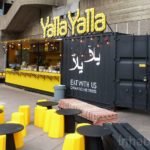There’s not much point in telling you about individual pop-ups since they will almost certainly be gone by the time you read about them. True, some might pop up somewhere else, or in some cases prove so popular that the instigators might gravitate towards permanent premises and try to make a go of it, though they are probably the exception rather than the rule.
It’s certainly worth writing about the phenomenon of pop-ups though, since they are, to coin a phrase, all the rage in London and many other cities globally.
What is a pop-up country dwellers might reasonably ask? Essentially they are restaurants that open for a very limited period, typically 6 months but often less, employing iconic spaces around a City that would not otherwise be used for this, or often for any purpose.
They might be open-air, might have almost no infrastructure whatever; some are barely more than takeaway vans with a couple of boxes or trestle-tables and chairs. They might employ niceties, but many are basic, focusing instead on food and atmosphere, which many would consider far and away the most critical elements of any restaurant venture. What they create is a sense of occasion, a quality that vanishes rapidly from most restaurants and is remarkably difficult to discover. Relaunches produce diminishing returns.
Pop-ups bring life to these odd corners, attract people and attract a buzz, but as this page points out they exist for many different reasons:
Pop-Up Restaurants Don’t Have a Time Limit.
Pop-up restaurants are temporary in nature. They can last for an evening, a week, or even a month. It all depends on how long the space is available and the purpose of the pop-up. For example, a pop-up for a fundraiser may last for only a weekend. A pop-up as a trial run for a traditional brick and mortar restaurant could last several weeks.
Pop-Up Restaurants Are Great for Fundraisers
Think of the traditional bean supper at local grange halls or spaghetti dinners to benefit a local sports team or other charitable cause. These are essentially pop-up restaurants in their most basic form. A pop-up restaurant takes this basic concept and steps it up a more traditional restaurant atmosphere.
Pop-Ups Pop Up in Unusual Locations
One of the coolest aspects of a pop-up restaurant is that it may be located in an unusual location, like an apartment building rooftop, an old barn, or even an empty airplane hangar.
Wherever there is room for tables and chairs and a make shift kitchen, you could host a pop-up restaurant. Just be sure that you have permission to use the space and it is safe for staff and customers (more about that in a second).
These reasons notwithstanding, pop-ups are sometimes established for very pragmatic reasons concerning the essential truth of restaurant life: the costs and notoriously high failure rate (once you exclude new branches of chains) of new restaurants mean security is at a premium, and subject to the whims of customers. In fact, tastes change and new eating establishments ope so rapidly, the likelihood is that even a great dining experience will not necessarily be rewarded with good word-of-mouth or repeat business.
No matter how good you are, no matter how switched-on with social media marketing, no matter how attractive your location and how enticing your food, there is no guarantee you can sustain the initial burst of interest, maybe on the back of an encouraging review.
Since such enterprises are often independent and run by a collective of friends rather than established restauranteurs, setup costs can be reduced by hiring the venue, the kitchen equipment, tables and chairs, even cutlery and crockery. This makes pop-ups quicker and easier to achieve, though they will of course have to demonstrate compliance with health & safety legislation, since outbreaks of food poisoning would close any pop-up far quicker than intended. Note also that most will not be licensed, so you might have to bring your own booze.
That apart, there is probably no better way to test out the concept and recipes on the paying public, which often yields surprising results. Pop-ups can afford to be more adventurous than full restaurants, since there is less to lose if the public fails to take to the owner’s ideas.
For example, I know of one such, opened by the daughter of a friend, combining two voguish elements: Sri Lankan hoppers and recipes from the Deep South of the USA – including catfish. The mixture might seem odd, but for a limited period it worked a treat – and diners are often happy to cross cultural boundaries and mix traditions without a second thought, even to the extent of ordering both on the same plate.
It seems therefore sensible to ride the wave for whatever period is appropriate and make the most of early full houses – and in the event that they don’t prove popular, the limited opening time will cut losses. The only question is whether a roaring success justifies a full opening, which is a very different business case and financing requirement.
While a pop-up could be financed through crowdfunding, the likelihood is that banks and venture capitalists would want demonstrable return on investment and a substantial return at that – even if, as the article above suggests, it is an excellent way to demonstrate the success of the principle and operational plan.
As for the restaurants themselves, their diversity and creativity can be judged by this and this selection of some of London’s best pop-ups. Keep your eye on Time Out and look for the latest pop-up adventures, then take your taste buds on a magical mystery tour!













